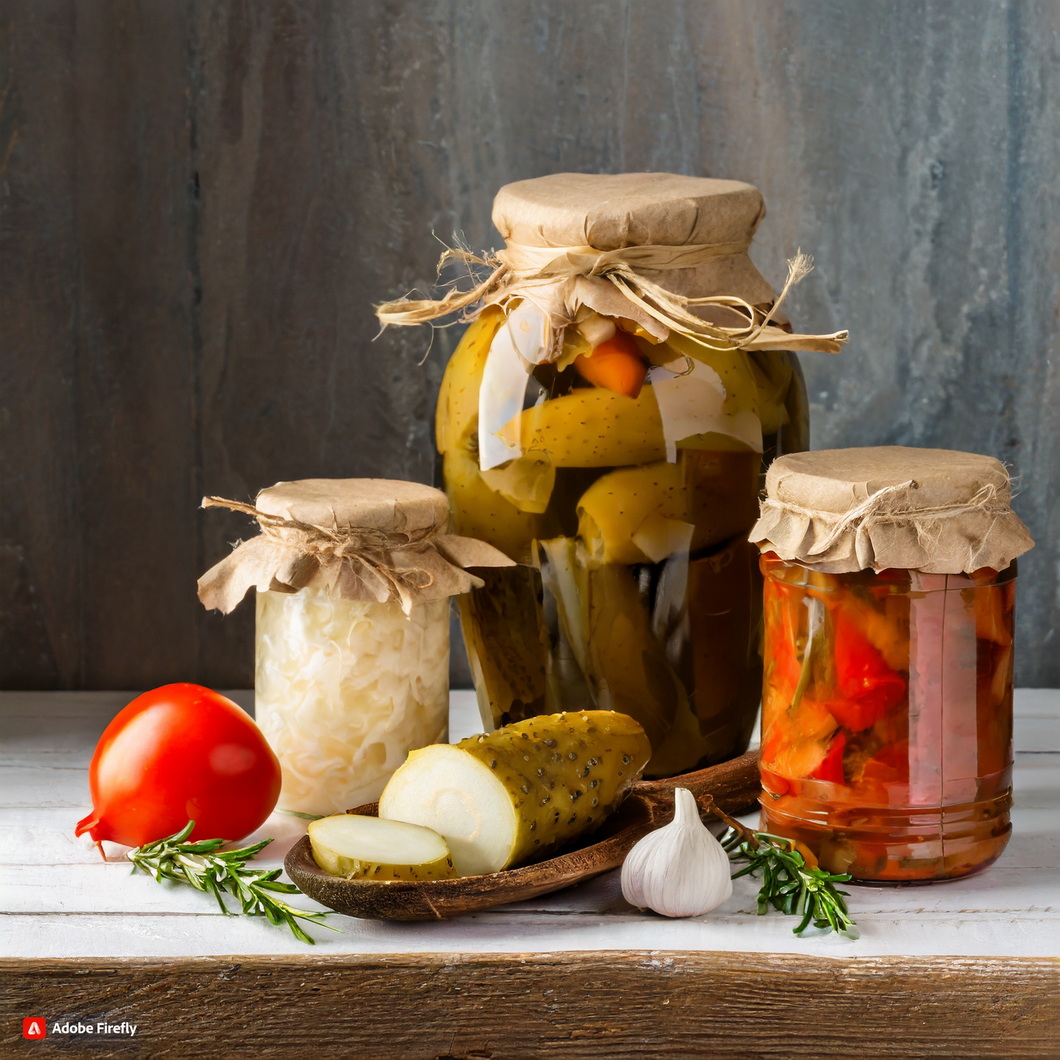Introduction
Fermented foods have been a staple in many cultures for centuries, and their significance goes far beyond just being a tasty addition to meals. These foods, preserved in jars, offer a glimpse into the history and traditions of different societies. From kimchi in Korea to sauerkraut in Germany, cultures around the world have their own unique methods and recipes for fermenting foods.

In this exploration, we will delve into the historical significance of Fermented foods and how they have shaped the cultures in which they originated.
The Evolution of Fermented Foods: A Look at How Cultures in Jars Have Shaped Culinary Traditions
Fermented foods have been a staple in many cultures for centuries, and their significance goes far beyond just being a tasty addition to a meal. These foods, often referred to as “cultures in jars,” have played a crucial role in shaping culinary traditions and have a rich history that is worth exploring.

The process of fermentation involves the breakdown of sugars by bacteria and yeast, resulting in the production of lactic acid. This process not only preserves food but also creates unique flavors and textures that have become beloved in many cuisines around the world.
One of the earliest examples of Fermented foods can be traced back to ancient Egypt, where beer was a staple in their diet. The Egyptians believed that beer was a gift from the gods and used it in religious ceremonies. They also used fermentation to preserve fruits and vegetables, which were essential during times of famine.
Moving on to ancient Greece and Rome, Fermented foods were also a significant part of their diets. The Greeks were known for their love of wine, which was made by fermenting grapes. They also used fermentation to make yogurt and cheese, which are still popular in Greek cuisine today.
In Rome, fermented fish sauce, known as garum, was a staple in many dishes. It was made by fermenting fish in saltwater and was used as a condiment in many dishes. The Romans also used fermentation to make bread, which was a crucial part of their diet.
As we move through history, we see that Fermented foods were not only used for preservation but also for medicinal purposes. In ancient China, Fermented foods such as soy sauce and miso were believed to have healing properties and were used to treat various ailments.
In the Middle Ages, Fermented foods played a vital role in the diet of Europeans. With limited access to fresh produce, fermentation was a way to preserve food and ensure a steady food supply throughout the year. Sauerkraut, a fermented cabbage dish, became a staple in German cuisine, and pickled vegetables were popular in many other European countries.
The colonization of the Americas also had a significant impact on the evolution of Fermented foods. The introduction of new ingredients, such as corn and potatoes, led to the creation of new fermented dishes. For example, the Native Americans used corn to make a fermented beverage called chicha, which is still enjoyed in South America today.
In more recent history, the Industrial Revolution brought about significant changes in the way food was produced and consumed. With the rise of mass production and refrigeration, the need for Fermented foods as a means of preservation decreased. However, many cultures continued to hold onto their traditional fermented dishes, and they have now become popular all over the world.
Today, Fermented foods are experiencing a resurgence in popularity, thanks to their unique flavors and potential health benefits. Foods like kimchi, kombucha, and kefir have become trendy, and people are starting to recognize the importance of incorporating these foods into their diets.
In conclusion, cultures in jars have played a significant role in shaping culinary traditions throughout history. From ancient civilizations to modern times, fermentation has been a crucial method of preserving food and creating unique flavors. So the next time you enjoy a jar of sauerkraut or a glass of kombucha, remember the rich history behind these cultures in jars.
From Kimchi to Sauerkraut: Uncovering the Cultural Roots of Fermented Foods in Jars
Fermented foods have been a staple in many cultures for centuries, and their popularity has only grown in recent years. From kimchi to sauerkraut, these foods have become a trendy health food, but their significance goes far beyond just being a passing fad. In fact, Fermented foods have a rich history and cultural significance that is worth exploring.
The process of fermentation involves the breakdown of sugars by bacteria and yeast, resulting in the production of lactic acid. This process not only preserves the food but also creates a unique flavor profile that is often tangy and sour. While fermentation can occur naturally, humans have been intentionally fermenting foods for thousands of years.

One of the earliest examples of Fermented foods can be traced back to ancient Mesopotamia, where beer was brewed using fermented grains. This practice then spread to other civilizations, including the Egyptians, Greeks, and Romans. In these cultures, Fermented foods were not only a source of nutrition but also had religious and ceremonial significance.
Moving forward in history, we can see the importance of Fermented foods in Asian cultures. In Korea, kimchi has been a staple food for over 2,000 years. This spicy and tangy side dish is made by fermenting vegetables such as cabbage, radish, and cucumber with a variety of seasonings. Kimchi is not only a delicious accompaniment to meals but also a symbol of Korean identity and pride.
Similarly, in Japan, fermented soybean products like miso and soy sauce have been a part of their cuisine for centuries. These foods not only add depth and flavor to dishes but also have health benefits due to the fermentation process. In fact, the Japanese have a saying, “miso for life,” highlighting the importance of this fermented food in their culture. Read easy Healthy Lunch for Weight Loss.

Moving to Europe, we see the widespread use of Fermented foods such as sauerkraut and pickles. These foods were not only a way to preserve vegetables during the winter months but also a source of nutrition for sailors on long voyages. In Germany, sauerkraut is a traditional accompaniment to sausages and is also used in dishes like stews and soups. Similarly, pickles are a popular snack in many European countries and are often served alongside meals. Read Dinner recipes for Weight Loss.
In addition to their cultural significance, Fermented foods also have numerous health benefits. The fermentation process increases the bioavailability of nutrients in foods, making them easier for our bodies to absorb. They also contain probiotics, which are beneficial bacteria that promote a healthy gut microbiome. This is why Fermented foods are often recommended for improving digestion and boosting the immune system.
Today, Fermented foods have become a global phenomenon, with people from all over the world incorporating them into their diets. Kombucha, a fermented tea drink, has gained popularity in the Western world, and kefir, a fermented milk drink, has become a staple in many health-conscious households. Read Breakfast Ideas for Weight Loss.
In conclusion, Fermented foods have a rich history and cultural significance that cannot be ignored. From ancient civilizations to modern-day health trends, these foods have stood the test of time and continue to be an important part of many cultures. So the next time you enjoy a jar of kimchi or sauerkraut, remember the cultural roots and historical significance of these delicious and nutritious foods.
Q&A
Q: What are some examples of cultures that are commonly found in jars?
A: Some examples of cultures that are commonly found in jars include sauerkraut, kimchi, pickles, and kombucha. These Fermented foods have a long history and cultural significance in various regions around the world.
Conclusion
In conclusion, cultures in jars, or Fermented foods, have played a significant role in human history. From ancient civilizations to modern societies, Fermented foods have been a staple in many cultures and have been used for various purposes such as preservation, flavor enhancement, and medicinal benefits. The process of fermentation has also been a way for different cultures to share and exchange their food traditions, leading to a diverse and rich culinary landscape.
Furthermore, the historical significance of Fermented foods goes beyond just food and has also influenced cultural practices, beliefs, and social interactions. As we continue to explore and appreciate the world of Fermented foods, we gain a deeper understanding and appreciation for the diverse cultures that have contributed to its development and evolution.
Please follow us on linkedin. You can learn all best canadian food recipes you can check our Culinary 1TouchFood Youtube and Telegram 1TouchFood page. Don’t forget Fighting Obesity Magazine and Radio Cooking.

